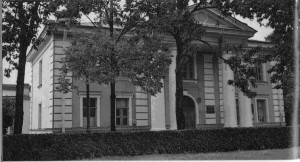After passing under the arch of the St Peter Gate, where one can still observe the signs of the former guides along which a grate was formerly lowered to block the path more securely, one sees the start of the main avenue of the fortress (whose full perspective is impeded by the central part of the main building of the Mint Works).
Stepping out into the avenue, a one-storey pink-and-white building with a high gabled roof commands one’s attention. It was built in 1748-49 for various offices of the Engineering Department, and this accounts for its name, the Engineers’ House. This is a rare example of a St Petersburg military structure built in the 1740s which has preserved its original exterior appearance almost without change. Considerably less imposing in its outward appearance is the long one-storey building located on the other side of the avenue opposite the Engineers’ House. It was built in 1801-2 as a storeroom for artillery, and towards the end of the nineteenth – beginning of the twentieth centuries was used as a manege. Walking further down the avenue past the Engineer’ House and the artillery storeroom, one soon sees another two buildings to the left. One of them, the small two-storey yellow-and-white building with corners decorated with rusticated masonry and a portico in which two pairs of columns support a triangular pediment, stands almost directly next to the Neva Curtain Wall and separated from the main avenue by a large lawn. The other is also two-storey, though somewhat larger, red-and-white, and located a bit further back behind a lane which cross-cuts the main avenue. To one’s right can be found the central architectural complex of the fortress, which includes two structures, built at different times and joined by a covered walkway: the Sts Peter and Paul Cathedral (standing directly next to the sidewalk of the main avenue) and the Grand Ducal Burial Vault (separated from the main avenue by a small garden bordered by a low metal fence). The yellow-and-white building served before the October Revolution of 1917 as the Main Guardhouse. It’s present appearance is the result of reconstruction in the style of Classicism which took place in 1907-8 on the formerly one-storey stone guardhouse built in 1750.
The large lawn located to the left of the main lane, from the eighteenth to the beginning of the twentieth centuries, was the site of the fortress drill ground.
Before the Revolution the red-and-white building (its pedimented facade executed in the Baroque style faces the Engineers’ House) was the residence of the fortress commandants, appointed from among the most distinguished generals of the Russian army. Hence its name – the Commandant’s House. The first stone Commandant’s House was built in 1748; at that time also a two-storey structure, but quite a bit smaller in size than the present house. In the years to follow, the Commandant’s House was enlarged and rebuilt several times.
It received its present dimensions and exterior view in 1893-94.
On October 24, 1917, in the Commandant’s House the field headquarters for the direction of an armed uprising against the Provisional Government was established, acting on the decision of the Petrograd Military-Revolutionary Committee.
Today on display in the Commandant’s House is an exhibition devoted to the history of St Petersburg – Petrograd up to February 1917. Among the items exhibited here, of particular interest are the old engravings, lithographs and paintings with images of the city, the works by leading Russian and foreign masters: Alexei Zubov, Mikhail Makhayev, John Augustus Atkinson, Benjamin Paterssen, Fiodor Alexeyev, Michel Francois Damame-Demartrais, Stepan Galaktionov, Karl Joachim Beggroff, Ferdinand Victor Perrot, Adolphe Charlemagne, Wilhelm Georg Timm, Anna Ostroumova-Lebedeva, Pavel Shillin-govsky, and others.
In the very first years of the fortress on the site of today’s Commandant’s House stood a large building which served as the Main Guardhouse, and nearby, on the site of today’s large lawn located to the left of the main fortress avenue, was the so-called “dancing square”. Here, according to a contemporary, “a big wooden horse was installed with a very sharp spine, on which as a punitive measure soldiers were made to sit for several hours,” and besides this “there was a wooden post sunk into the ground in front of which sharp spikes were installed, and above the post was a chain… When someone was being punished, his hands were locked into this chain, and the guilty was made to stand on those spikes for a time.”





